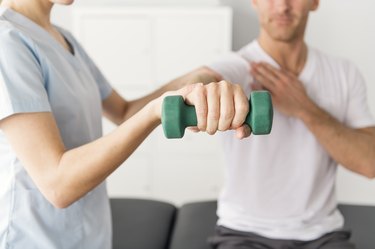
Active-assisted range of motion, or AAROM, exercises help individuals to restore or maintain the full range of motion after an injury or illness. In these movements, a provider or helper assists the individual in completing the movement.
Tip
When doing active-assisted range of motion exercises, you will perform movements with the assistance of a physical therapist or another helper to support you during the movement. Unlike passive range of motion exercises in which the provider moves your limbs for you, you activate your muscles and help in the movement.
Video of the Day
Range of Motion Assessment
Each joint or body part has a normal range of motion that makes it easier for you to perform both day-to-day and athletic activities. Injuries and lack of exercise and stability may result in a limited range of motion. For example, fractured bones, dislocated joints, swelling of the soft tissue around a joint and muscle stiffness are all factors that may prevent full movement.
Video of the Day
Some medical conditions such as stroke, rheumatoid arthritis, osteoarthritis and cerebral palsy may also result in a limited range of motion, advises Medline Plus. Determining the cause of the lack of range of motion allows medical providers to determine the best exercises to restore movement.
Warning
Be sure to consult your doctor before doing any new exercise program. If you are doing active-assisted range of motion exercises, be sure your helper has been taught how to do the movement so as not to cause further damage to the muscles or joints.
Your provider may prescribe active-assisted range of motion exercises based on the range of motion assessment. Unlike unassisted range of motion exercises, a helper supports your limbs and joints through the movement until your strength and range of motion have returned and you are able to progress to performing the movements on your own. Your helper may also provide resistance during the movement to help increase strength.
Range of Motion Exercises
Range of motion exercises vary depending on the body parts affected. For example, if you suffer a stroke, your doctor may recommend exercises for your arm on the weakened side of your body as you recover control and movement over your muscles.
Here are some exercises recommended by Wexner Medical Center:
- Shoulder abduction and adductions: Standing with your arm at your side and elbow bent at a 90-degree angle, your helper will assist in raising your arm to the side. Do not go higher than shoulder height. Return to the starting position.
- Shoulder flexion and extension: Starting with your arm bent at your side, your helper will assist you to reach your arm forward and then return your elbow back to your side. Keep your body still and isolate the movement in your arm.
- Elbow flexion and extension: Start with your arm straight and to your side. With the assistance of your helper, bend your elbow, bringing your hand toward your shoulder. Then straighten the elbow.
- Internal and external arm rotations: Bend your arm and keep your elbow at your side. Your helper will assist as you rotate your hand and forearm out to the side then return to the starting position.